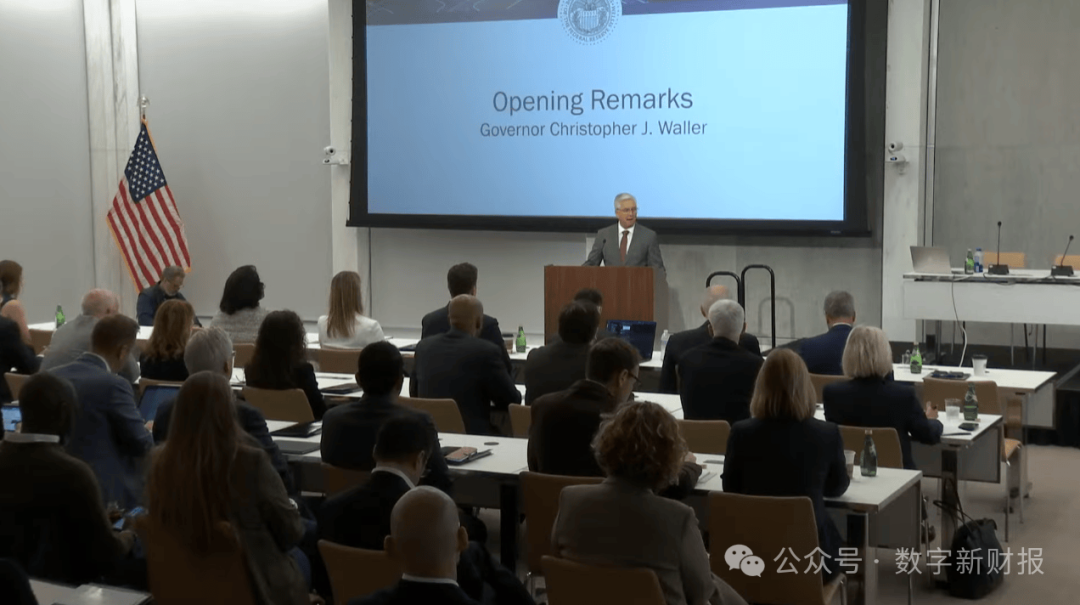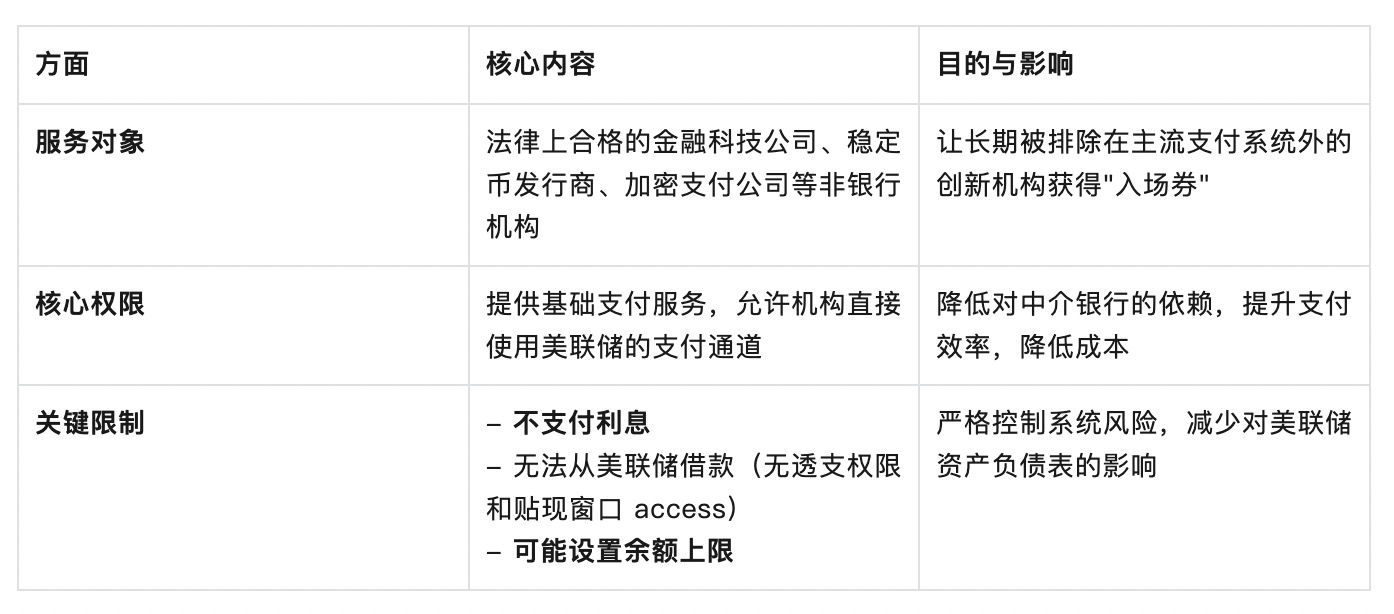Author: Zhang Feng
The historic closed-door meeting of the Federal Reserve has quietly changed the position of cryptocurrencies in the global financial system. On October 21, Federal Reserve Governor Christopher Waller clearly stated at the inaugural "Payment Innovation Conference" held at the Federal Reserve headquarters that "the DeFi industry is no longer viewed as suspicious or ridiculed; the Federal Reserve will actively embrace payment innovation." This so-called "historic" meeting is unusual—it no longer regards cryptocurrencies as a marginal threat to the financial system but discusses them as a key component of the future payment system.

Even more noteworthy is that the Federal Reserve proposed a specific concept of a "streamlined master account," providing basic payment services for non-bank payment companies, which means that stablecoin issuers and crypto payment companies are expected to directly access the Federal Reserve's payment system, freeing themselves from reliance on traditional banks.
1. From Skepticism to Embrace: A Major Shift in the Federal Reserve's Attitude
Global payment innovation has entered an accelerated phase, with stablecoin cross-border applications, traditional asset tokenization, and AI-driven payment security technology becoming industry focal points. In this context, the Federal Reserve's choice is not to resist but to actively participate and guide the direction of innovation. This meeting marks a fundamental shift in the U.S. regulatory stance towards crypto assets and AI payments. The Federal Reserve's position has shifted from past vigilance and skepticism to current openness and acceptance, reflecting its recognition of the trend of financial innovation.
Governor Waller elaborated on the Federal Reserve's dual role in payment innovation: first, acting as a convener to solve coordination issues, and second, operating core payment and settlement infrastructure. He emphasized that the Federal Reserve is "looking to the future, conducting practical research on tokenization, smart contracts, and the intersection of artificial intelligence and payments." Behind this change in attitude is the Federal Reserve's clear understanding of the current payment revolution.
2. A New Financial Era of AI and Asset Tokenization
The conference discussed four core topics: the integration of traditional finance and digital assets, stablecoin business models, the application of AI in payments, and tokenized products, outlining a clear picture of the future payment ecosystem.
In terms of AI applications, ARK Invest CEO Cathie Wood proposed that AI-driven "agent payment systems" will usher in the "Agent Business" era. She believes that AI can not only "know" but also "execute," representing users in making autonomous financial decisions. Wood predicts that the immense productivity released by the combination of AI and blockchain is expected to drive the growth rate of U.S. real GDP to 7% over the next five years.
Richard Widmann, Head of Web3 Strategy at Google Cloud, pointed out the perfect match between AI and stablecoins, stating, "AI agents cannot open traditional bank accounts like humans, but they can have crypto wallets, and the programmability of stablecoins makes them perfectly suited for AI-driven automated microtransactions and machine-to-machine settlement scenarios."
Asset tokenization is another major focus. Traditional financial institutions are accelerating their layout in this area. By 2025, the global market size for tokenized assets is expected to be around $28 billion. Although it is growing rapidly, it is still far below the total size of the U.S. ETF industry.
3. "Streamlined Master Account" Bridges the Last Mile
The most noteworthy policy innovation from this meeting is the Federal Reserve's proposal for a "streamlined master account." This initiative is expected to pave the way for non-bank payment companies to directly access the Federal Reserve's payment system, fundamentally reducing operational costs and improving efficiency.

The proposal for the "streamlined account" marks a fundamental shift in the Federal Reserve's attitude towards financial technology, especially crypto assets—from past skepticism and scrutiny to active acceptance and integration. As Federal Reserve Governor Waller clearly stated, the DeFi industry is no longer viewed with suspicion or ridicule; the Federal Reserve will "embrace disruption rather than evade destruction." This initiative is expected to resolve the long-standing difficulties faced by companies like Custodia Bank and Kraken in seeking master accounts and accelerate the approval process for companies like Ripple that have already submitted applications. In the long run, this is not just a technical access issue but an evolution of the financial system's structure. It signals that the "pipeline" privileges of traditional banks in the payment sector will be weakened, and fintech companies will gain direct channels to communicate with central banks, which is expected to greatly promote innovation and competition in the payment field.
For the crypto industry, this initiative is of profound significance. Crypto journalist Eleanor Terrett pointed out that this move is significant for companies like Custodia Bank and Kraken, which have been trying to obtain a Federal Reserve master account for years, with Custodia even suing the Federal Reserve. Companies like Ripple and Anchorage, which applied this year, may also accelerate their access qualifications as a result.
4. Opportunities and Challenges for Hong Kong and the Mainland
The participating institutions included banks, asset management companies, retail payment companies, technology companies, and crypto-native fintech companies, reflecting that distributed ledger technology and crypto assets are no longer on the fringes but are increasingly integrated into the payment and financial system architecture. The Federal Reserve's series of actions provides strong endorsement for the further integration of traditional finance and crypto assets.
Overall, the Federal Reserve's payment innovation conference has pointed out the general direction for financial digitization in Hong Kong and the Mainland. The key for Hong Kong lies in how to balance risk in openness, while the focus for the Mainland is on how to innovate applications based on its own realities. In the context of AI and blockchain integration giving rise to new financial infrastructure, both regions should leverage their respective advantages to better participate in shaping the future global financial landscape.
For Hong Kong, on one hand, it can consolidate its position as a financial hub. Hong Kong has a practical foundation in the field of asset tokenization; for example, HSBC has completed cross-border U.S. dollar tokenized deposit transactions. The Federal Reserve's movements will further promote the global financial digitization process, **and Hong Kong can seize this opportunity to actively develop the tokenization market and explore payment innovations combined with **AI, attracting more international capital and projects, thereby consolidating its status as an international financial center.
On the other hand, Hong Kong faces competition and regulatory pressure. As an international free port, while actively introducing innovative businesses, Hong Kong also faces the challenge of how to balance encouraging innovation with preventing financial risks. The Federal Reserve's exploration of a stablecoin regulatory framework means that Hong Kong also needs to establish a corresponding regulatory system to address potential cross-border risk transmission.
For the Mainland, on one hand, it can leverage the opportunity to develop its own technology. The Mainland has already established technical standards in financial certification and payment security. Based on this, **it can accelerate the deep integration of blockchain and *AI* technologies in scenarios such as payments, identity verification, and supply chain finance.** At the same time, the Federal Reserve's exploration also provides valuable experience for the Mainland to promote technological applications under the premise of controllable risks.
On the other hand, the Mainland needs to address technological competition and gaps. The Federal Reserve's actions may accelerate the digital competition of global financial infrastructure. If Hong Kong and the Mainland cannot keep pace, they may face risks of lagging behind in areas such as cross-border payments and digital asset pricing power. Additionally, differences in technological routes may lead to challenges in the future interconnectivity of different digital financial ecosystems.
The Federal Reserve's meeting is just the beginning. As the "streamlined master account" moves from concept to reality, stablecoin issuers and crypto payment companies will directly access the Federal Reserve's payment system, and the traditional bank-dominated financial fortress is showing structural cracks. **The integration of *AI* and blockchain may push this transformation even deeper.** Richard Widmann, Head of Web3 Strategy at Google Cloud, pointed out that AI agents cannot open traditional bank accounts like humans, but they can have crypto wallets. Future financial transactions may no longer be dominated by humans but could be automatically completed between AI agents through crypto wallets.
Standing at this historical turning point, regulatory agencies around the world must make a choice—whether to build higher walls or embrace the irreversible trend. The Federal Reserve has already made its choice.
免责声明:本文章仅代表作者个人观点,不代表本平台的立场和观点。本文章仅供信息分享,不构成对任何人的任何投资建议。用户与作者之间的任何争议,与本平台无关。如网页中刊载的文章或图片涉及侵权,请提供相关的权利证明和身份证明发送邮件到support@aicoin.com,本平台相关工作人员将会进行核查。




